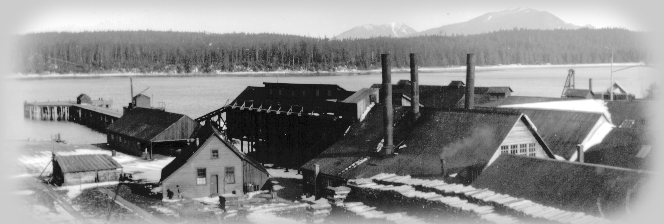Killisnoo Plant and the Angoon Bombardment of 1882

(Vincent Soboleff collection, PCA 1-339, Alaska State Library--click to enlarge)
----WARNING: "ALPHA" Draft Status This page is still under major development!!
---Text is not intended to be readable---for author's use only!!!!
The Favorite was an 80 foot steam-powered vessel built at Portland, Oregon, in 1874. She was purchased by the Northwest Trading Company in 1880, outfitted and first captained by Captain James W. Keene, being initially used by the company for whaling work. She was several times chartered by the Navy for survey work and was a frequent early visitor in Juneau. Serving her owners as a trading vessel and later as a fishing vessel for the herring reduction plant at Killisnoo, she continued in operation until about 1900 (source). It was the Favorite that was involved in the infamous naval bombardment of Angoon in the fall of 1882. The Favorite carried the plant superintendant, Capt. J. M. Vanderbilt, to Sitka in his request for naval assistance, and later returned to assist that naval forces in their action (source).
A beaver canoe prow which survived the bombardment and burning was recently returned to Angoon from the American Museum of Natural History. A letter from a crewman aboard the Adams was recently discovered which sheds considerable new light on the incident, from an informal perspective.
In its handling of the bombardment incident, the Northwest Trading Company would not be expected to be too insensitive to the needs of the cultures in whose midst they were living, trading, and who they were employing. Such sensitivity must have been important at least in a commercial and competitive sense, for Mohr (1979) describes how "The new company successfully took some of the Native hunters from the Alaska Commercial Company at Unalaska by building frame houses for their families and offering other inducements." Perhaps Capt. ___ (of the Favorite) was somewhat panicked by the events of October 1882 in going to seek assitance from the Navy at Sitka, but did not anticipate the far-reaching consequences of the Navy's reaction. (needs more analysis.....) At any rate, the company was able to resume peaceful coexistence with its neighbors fairly quickly, convert the plant to herring processing, and resume business operations.
In her "travelogue" style of writing, visiting Killisnoo in the year after the bombardment, Scidmore (1885) downplays the entire incident as considerably overdone in the eastern press she had read prior to her visit. She relates an impression of peaceful cooperation between the company and the villagers.
Scidmore, in her 1891 appeal for Washington to pay attention to Alaska, reveals considerable understanding of native resentments
Back to: History of Southeast Alaska Herring Fisheries
Link to: References
Caution: These pages contain preliminary research results, and are presented here only to further collaborative research and analysis. The information presented has not been fully analyzed or verified for correctness. Please consult the original literature citations for authentic interpretations or contact the author regarding applications of any analysis presented on these pages.
For more information, contact Fritz Funk:
fritz funk.io
| Last modified: Apr 12, 2008 at 21:14:42
funk.io
| Last modified: Apr 12, 2008 at 21:14:42

